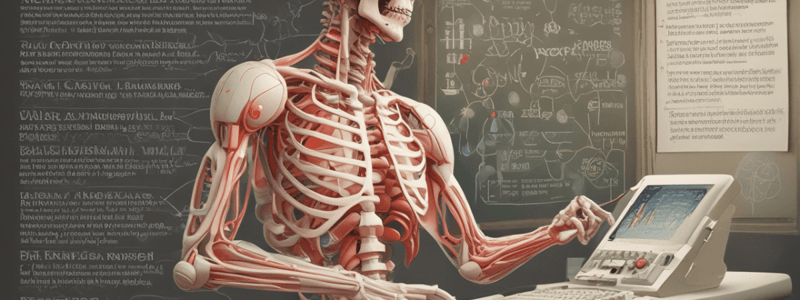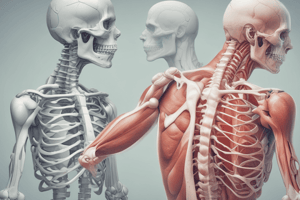Podcast
Questions and Answers
What is a characteristic of osteoporosis?
What is a characteristic of osteoporosis?
- Buildup of uric crystals in the joints
- Inflammation in the joints
- Spongy and not as dense bone (correct)
- Dense bone structure
What is the primary cause of pain and inflammation in gout?
What is the primary cause of pain and inflammation in gout?
- Uric crystals buildup in the joints (correct)
- GI toxicity
- Calcium deficiency
- Bone marrow suppression
What is the therapeutic class of Colchicine?
What is the therapeutic class of Colchicine?
- Antihistamine
- Anti-inflammatory
- Pain reliever
- Antigout (correct)
What is a common adverse effect of Colchicine?
What is a common adverse effect of Colchicine?
Why is Colchicine reserved for certain clients?
Why is Colchicine reserved for certain clients?
What is the recommended route of administration for Colchicine?
What is the recommended route of administration for Colchicine?
What is a nursing consideration for clients taking Colchicine?
What is a nursing consideration for clients taking Colchicine?
What is the primary goal of using Colchicine to treat gout?
What is the primary goal of using Colchicine to treat gout?
What is a common location for gout attacks?
What is a common location for gout attacks?
Why is it important to take Colchicine with food and a full glass of water?
Why is it important to take Colchicine with food and a full glass of water?
What is the primary goal of administering calcium salts to patients with hypocalcemia?
What is the primary goal of administering calcium salts to patients with hypocalcemia?
Which of the following is a major contraindication for the use of calcium salts?
Which of the following is a major contraindication for the use of calcium salts?
What is the mechanism of action of alendronate (Fosamax)?
What is the mechanism of action of alendronate (Fosamax)?
Which of the following is a rare adverse effect of alendronate (Fosamax)?
Which of the following is a rare adverse effect of alendronate (Fosamax)?
What is the primary therapeutic use of hydroxychloroquine (Plaquenil)?
What is the primary therapeutic use of hydroxychloroquine (Plaquenil)?
What is the primary adverse effect of methotrexate?
What is the primary adverse effect of methotrexate?
What is the primary goal of administering allopurinol?
What is the primary goal of administering allopurinol?
What is the primary nursing consideration for patients taking alendronate (Fosamax)?
What is the primary nursing consideration for patients taking alendronate (Fosamax)?
What is the primary laboratory test to monitor for patients taking methotrexate?
What is the primary laboratory test to monitor for patients taking methotrexate?
What is the primary patient education for patients taking allopurinol?
What is the primary patient education for patients taking allopurinol?
What is the main reason why patients with osteoporosis may exhibit symptoms of hypercalcemia?
What is the main reason why patients with osteoporosis may exhibit symptoms of hypercalcemia?
What is the primary difference between the treatment of acute gout attacks and chronic gout?
What is the primary difference between the treatment of acute gout attacks and chronic gout?
Why is it crucial to monitor patients taking Colchicine for signs of bleeding and bruising?
Why is it crucial to monitor patients taking Colchicine for signs of bleeding and bruising?
What is the primary benefit of taking Colchicine with food and a full glass of water?
What is the primary benefit of taking Colchicine with food and a full glass of water?
What is the main characteristic of osteoporosis that distinguishes it from other musculoskeletal disorders?
What is the main characteristic of osteoporosis that distinguishes it from other musculoskeletal disorders?
Why is Colchicine reserved for certain clients who cannot tolerate safer agents?
Why is Colchicine reserved for certain clients who cannot tolerate safer agents?
What is the primary benefit of using antidiarrheal agents in conjunction with Colchicine?
What is the primary benefit of using antidiarrheal agents in conjunction with Colchicine?
What is the primary reason for administering calcium salts in the morning?
What is the primary reason for administering calcium salts in the morning?
What is the primary action of alendronate (Fosamax) on osteoclasts?
What is the primary action of alendronate (Fosamax) on osteoclasts?
What is the primary mechanism of action of hydroxychloroquine (Plaquenil)?
What is the primary mechanism of action of hydroxychloroquine (Plaquenil)?
What is the primary reason for monitoring liver function tests in patients taking allopurinol?
What is the primary reason for monitoring liver function tests in patients taking allopurinol?
What is the primary goal of administering methotrexate in patients with autoimmune disorders?
What is the primary goal of administering methotrexate in patients with autoimmune disorders?
What is the primary reason for encouraging patients taking allopurinol to avoid foods high in purine?
What is the primary reason for encouraging patients taking allopurinol to avoid foods high in purine?
What is the primary adverse effect of methotrexate that requires monitoring of liver function tests?
What is the primary adverse effect of methotrexate that requires monitoring of liver function tests?
What is the primary reason for taking hydroxychloroquine (Plaquenil) with milk?
What is the primary reason for taking hydroxychloroquine (Plaquenil) with milk?
Flashcards are hidden until you start studying
Study Notes
Musculoskeletal Disorders
- Osteoporosis: a condition characterized by weakened bone that is spongy and not as dense, causing symptoms of hypercalcemia since calcium is not being deposited into the bone.
Hypocalcemia and Hypercalcemia
- Hypocalcemia: a condition characterized by low calcium levels in the blood.
- Hypercalcemia: a condition characterized by high calcium levels in the blood, causing symptoms such as muscle weakness, nausea, and vomiting.
Gout
- Gout: a condition characterized by uric crystals building up in the joints, causing pain and inflammation, most commonly in the big toe.
- Prototype drug: Colchicine (Therapeutic class: Antigout drug; Pharmacologic Class: Anti-inflammatory agent)
- Actions and uses: reserved for clients who cannot tolerate safer agents, decreases inflammation caused by gout, and reduces the incidence of acute attacks for chronic gout.
Calcium Salts
- Prototype drug: Calcium Salts (Therapeutic class: Calcium Supplement; Pharmacologic Class: Hypocalcemia agent)
- Actions and uses: used for mild hypocalcemia and osteoporosis, and for severe cases, returns calcium serum levels to normal with constant monitoring of serum calcium.
- Administration alerts: take with meals or within 1 hour following meals, and with a full glass of water.
Biphosphonates
- Mechanism of action: suppresses the activity of osteoclasts, breaking down bone and putting calcium into the bloodstream.
- Prototype drug: Alendronate (Fosamax) (Therapeutic class: Drug for Osteoporosis; Pharmacologic Class: Biphosphonate)
- Actions and uses: decreases the number and action of osteoclasts, inhibiting bone resorption.
- Adverse effects: esophageal irritation, GI issues, hypocalcemia, and osteonecrosis of the jaw (rare).
DMARDs (Disease-Modifying Antirheumatic Drugs)
- Prototype drug: Hydroxychloroquine (Plaquenil) (Therapeutic class: Antirheumatic drug; Antimalarial; Pharmacologic Class: Disease-modifying antirheumatic drug (DMARDs))
- Actions and uses: relieves severe inflammation.
- Adverse effects: anorexia, GI disturbances, hair loss, headache, mood changes, and ocular effects.
Xanthine Oxidase Inhibitors
- Prototype drug: Allopurinol (Therapeutic class: Antigout Agent; Pharmacologic Class: Xanthine Oxidase Inhibitor)
- Actions and uses: inhibits uric acid production, used for chronic gout.
- Administration alerts: encourage intake of 2-3 liters of fluid a day, monitor I&O, uric acid levels, CBC, Urinalysis, and liver and kidney function tests.
- Adverse effects: kidney disorder, hepatitis, and GI distress.
Studying That Suits You
Use AI to generate personalized quizzes and flashcards to suit your learning preferences.




